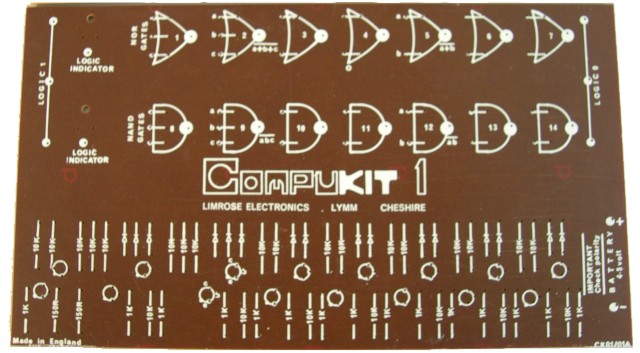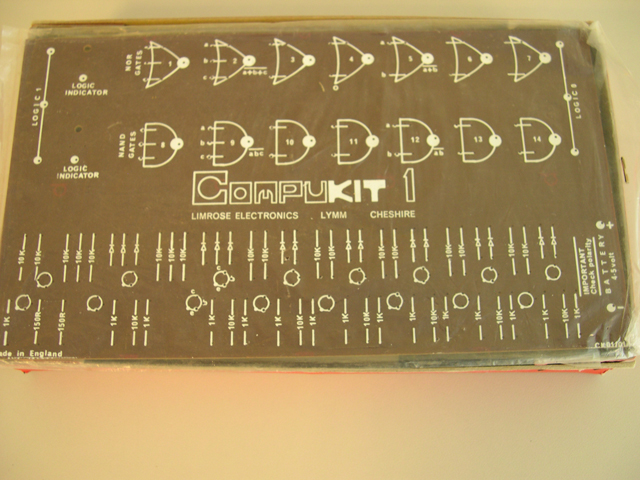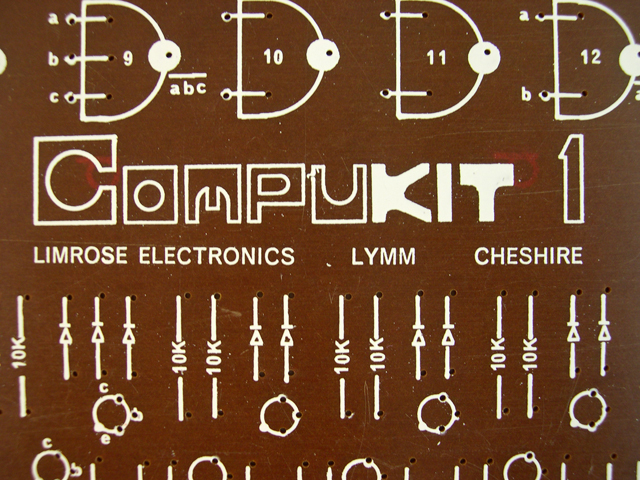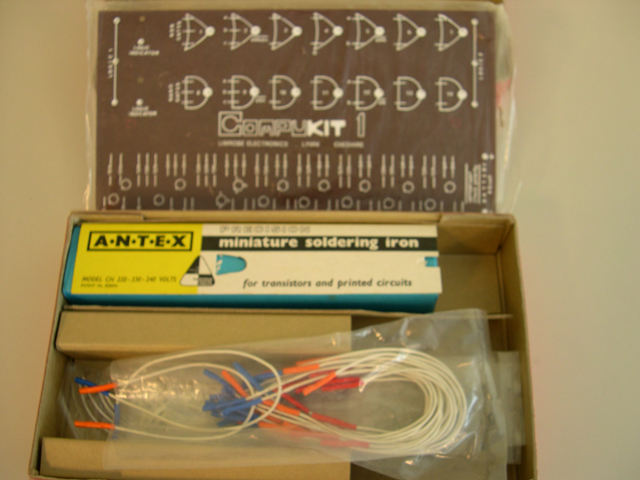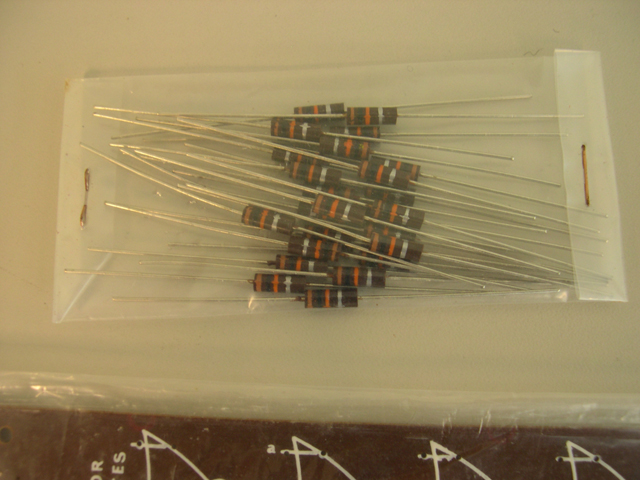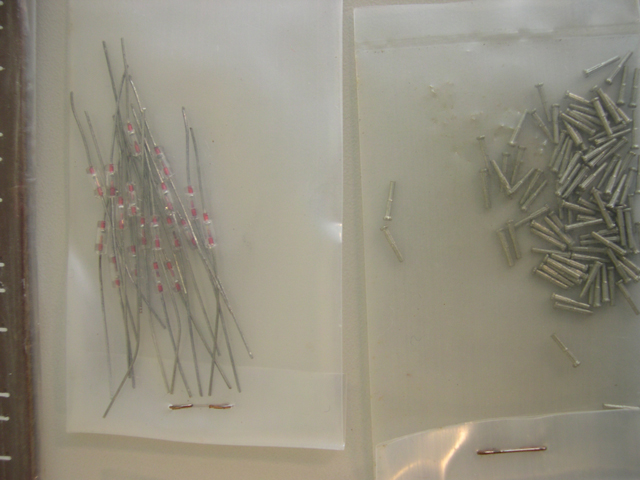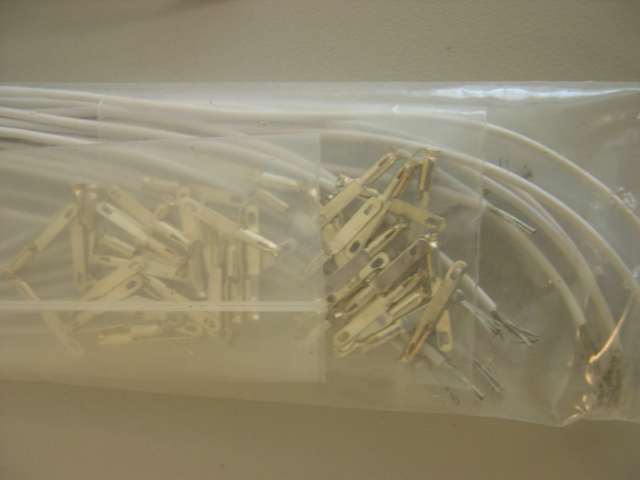 |
We are brick & mortar now!!
Visit us in Parkesburg, PA For more info: www.TheComputerChurch.org (This site no longer maintained.) |
YEAR: 1970
COMPANY: Limrose Electronics
COUNTRY: England
IN OUR COLLECTION: Yes

Although it is a training device, the Compukit 1 may qualify as one of the earliest personal computers ever offered to the public. It pre-dates contenders such as the Kenbak-1 and the NRI 832 by several months. The only digital personal computer we know of that is older is the COMSPACE-650.
The Compukit 1 is, as you might suspect, a kit that the buyer assembled on his/her own. It arrived in a bright red box that was filled with everything that was needed to build it, including a soldering iron and solder. (Of course, you still had to supply your own batteries...some things never change.) Once it was assembled, the buyer had a "mini-computer' that would add binary numbers and manipulate negative numbers. It was described in the accompanying flyer1 as "a logic simulator and educational aid for teaching the fundamentals of computer electronics, digital logic and Boolean algebra". It was, according to the flyer, the "Ideal gift for intelligent teenagers, amateurs, students, teachers and business executives."
If you wanted to buy several of these kits, you could connect them together. At the ITEX70 conference in Manchester in 1970, Limrose Electronics exhibited ten connected kits that could play "Noughts & Crosses" (that's Tic-Tac-Toe for those of us living in the colonies) against a human opponent.
The Compukit 1 was created by Dr. Ravi Raizada who founded Limrose Electronics (now Limrose Group). The flyer points out that the Instruction Book was written by "a Fellow of the British Computer Society". Since Dr. Raizada is a Fellow of the British Computer Society we are assuming that he wrote the Instruction Manual. At one point in his life, Dr. Raizada lived right here in Pennsylvania where he taught at Penn State University (Although I haven't had the opportunity to chat with him, I think he would have been much happier at West Chester University which is part of the Pennsylvania State System of Higher Education!)
The Compukit 1 in our collection was never assembled. It still has the transistors, diodes, resisters, mounting clips and 2 miniature indicator lamps in their original plastic bags. The box for the soldering iron is in the kit but the soldering iron itself is missing...guess it found a use on another project!
Recently (Feb. 2021), a really nice article was published by deftcoyote at HACKADAY.IO on the Compukit 1. It has some great artwork. If you are interested, you can find it here.
1Two flyers and an Instruction Manual were included with the Compukit in our collection. The two flyers are dated October 1970 and November 1970. The 16 page Instruction Manual is simply dated 1970.
Related Item 2: Compukit 2 Brochure
Hi ravi uncle jee. I am old friend raju argal son. My cell no 08435993224. I am 52 year your friend raju is no more I am dealing with scientific instrument same trade and lpg fittings indian oil corporation job.
Hi ravi uncle jee. I am old friend raju argal son. My cell no 08435993224. I am 52 year your friend raju is no more I am dealing with scientific instrument same trade and lpg fittings indian oil corporation job.
Hi ravi uncle jee. I am old friend raju argal son. My cell no 08435993224. I am 52 year your friend raju is no more I am dealing with scientific instrument same trade and lpg fittings indian oil corporation job.
|
Copyright © 2025 by Early Computers Project, All Rights Reserved. |
(Analogs in blue)
- AIM-65 (single board)
- AIM-65 (factory case)
- AIM-65 (Jon Titus)
- ALICE micro-ordinateur
- Altair 680
- Altair 8800
- Altair 8800A
- Altair 8800b
- Altair 8800b Turnkey (see Pertec below)
- Altair 8800b (see Pertec below)
- Altair 8800b w/ Hardisk Controller & Datakeeper
- Altos ACS-8000
- American Basic Science Club Analog Computer
- AMF Educational Computer
- Apple II Plus
- ASCI SystemX
- ASR 33 Teletype
- Automatic Teaching Computer Kit
- Beckman ElectroComp Electric Heating Computer
- Beckman ElectroComp Energy Savings Computer
- Beckman Solid State Fuel Cost Computer
- Brainiac K-30
- Calif. Computer Systems 2200
- CES Ed-Lab 650
- Commodore 8032
- Commodore 64
- Commodore PET 2001
- Commodore Super Pet
- Compucolor II
- Compukit 1
- Compukit 1 Deluxe Model
- Compukit 2
- Compukit UK101
- Comspace CT-650
- Cosmac Elf (RCA1802)
- Cosmac Microtutor
- Cosmac Netronics ELF II
- Cosmac VIP
- Cromemco System I
- Cromemco System III
- Cromemco Z-2D
- Datapoint 2200
- Digi-Comp I (flat box)
- Digi-Comp I (square box)
- Digital Computer Lab
- Donner 3500
- Durango F-85
- Dynabyte
- E & L Inst MMD-1
- E & L Inst MMD-2
- Eagle II
- Electric Tabulating Machine (one original counter, 1889)
- Electronic Associates TR-10
- Electronic Associates TR-10 Model II
- Electronic Associates TR-20
- Electronic Associates TR-48
- Electronic Associates Model 180
- Electronic Associates Model 380 Hybrid
- Geniac
- Google Glass (definitely not vintage)
- Heath EC-1 (factory assembled by Heath)
- Heathkit EC-1 (kit)
- Heathkit ET 3100 trainer
- Heathkit H8
- Heathkit H9 Video Terminal
- Hickok Logic Teaching Sys.
- Hickok Servo Teaching Sys.
- HP 2115A
- HP 85
- HP 5036A
- HP 9825A
- HP 9825B
- HP 9830A
- Iasis 7301
- I-COR MAC-1
- ICS Microcomputer Training System
- IMSAI 108 (prototype)
- IMSAI 8048 Control Computer
- IMSAI 8048 (The Dollhouse Computer)
- IMSAI 8080
- IMSAI PCS-40
- IMSAI PCS-80
- IMSAI VDP-80
- Informer
- Intel Intellec MDS
- Intel MDS-800
- Intel Prompt 48
- Intel SBC 80/10
- Intel SDK-85
- Intel SDK-85 (unassembled)
- Intel SDK-86
- Intertec Superbrain
- ITT MP-EX
- JR-01 Computer
- KIM-1
- LAN-DEC
- LAN-DEC 20
- LAN-ALOG
- Lehrcomputer (Germany)
- Lawrence Livermore Lab
- Lear Siegler ADM3A
- Logikit LK255 (Feedback)
- Logix SF-5000 Electronic Computer
- MAC-1 Mini Analog Computer
- MAC Tutor (Bell Laboratories)
- MEK6800D2
- Micro 68
- Microtan 65
- Midwest Scientific Instruments 6800
- Minivac 601
- Minivac 6010
- Mini-Scamp Microcomputer
- Nascom I
- Nascom II
- National Radio Institute 832
- NEC TK-80
- NorthStar Horizon
- Olivetti Programma 101
- Olivetti Programma 203
- Olivetti Programma 602
- Open University PT501
- Ordinateur d'Apprentissage JR-01
- Osborne 1
- OSI 300
- OSI 600 (SuperBoard II)
- OSI C2-OEM-4
- OSI Challenger-1P
- Pastoriza Personal Analogue Computer
- Pertec MITS 300/25 (Altair desk business system)
- Pertec MITS 300/55 (Altair Turnkey business system)
- PolyMorphic Systems 8810
- PolyMorphic Poly-88
- Protech-83
- Range Keeper Mk.6 Mechanical Analog Computer, 1926
- Range Keeper Mk.7 Mechanical Analog Computer, 1935?
- Sargent-Welch Scientific Company Cat. No.7528 Analog Computer
- Science of Cambridge MK-14 (Sinclair)
- SD Systems Z80 starter kit
- Sharp MZ-40K
- Sharp MZ-80k
- Siemens ECB-85
- Signetics Instructor 50
- Sinclair ZX-81
- Smoke Signal Broadcasting
- Sol-20
- Spark16
- Sphere 1
- Sphere/SWTPC Computer System
- SWTP CMOS Microlab
- SWTP CT-82 Terminal
- SWTPC 6800
- SWTPC 6800 (w/ Smoke Signal Broadcasting drive)
- SWTPC CT-64 Video Terminal, SS-50
- SWTPC TV Typewriter II CT-1024
- Synertek VIM-1
- Synertek SYM-1
- Systron-Donner 3500
- Tei MCS-112
- Tektronix 4006-1
- Telefunken RAT 700
- TI LCM-1001 (Microprogrammer)
- TI LCM-1001 (Microprogrammer)
- TI Silent 700 Terminal
- TI TM 990/189
- Vector 1
- Vector 3
- Vidac 336
- Wang 2200
- Welch Scientific Company Cat. No.7528 Analog Computer
- Xerox 820 Mark I
- Chameleon Plus
- Commodore SX64
- Epson HX-20
- Kaypro I
- Kaypro II
- Kaypro 2x
- Kaypro 16
- Osborne 1
- Panasonic Senior Partner
- Visual Commuter
- Babbage's Calculating Engine (1834)
- Electric Tabulating Machine (1889, Herman Hollerith's personal copy)
- The Hollerith Electric Tabulating System (1890)
- Counting a Nation by Electricity (1891)
- Calculating Machines (1947)
- Moore School Lectures Vol. II (1947)
- Mathematical Theory of Communication (1948)
- Communication Theory of Secrecy Systems (1949)
- The "Moore's Law" article (Electronics, 1965)
- Printout from Babbage's Difference Engine #2 (London Science Museum, 2004)

